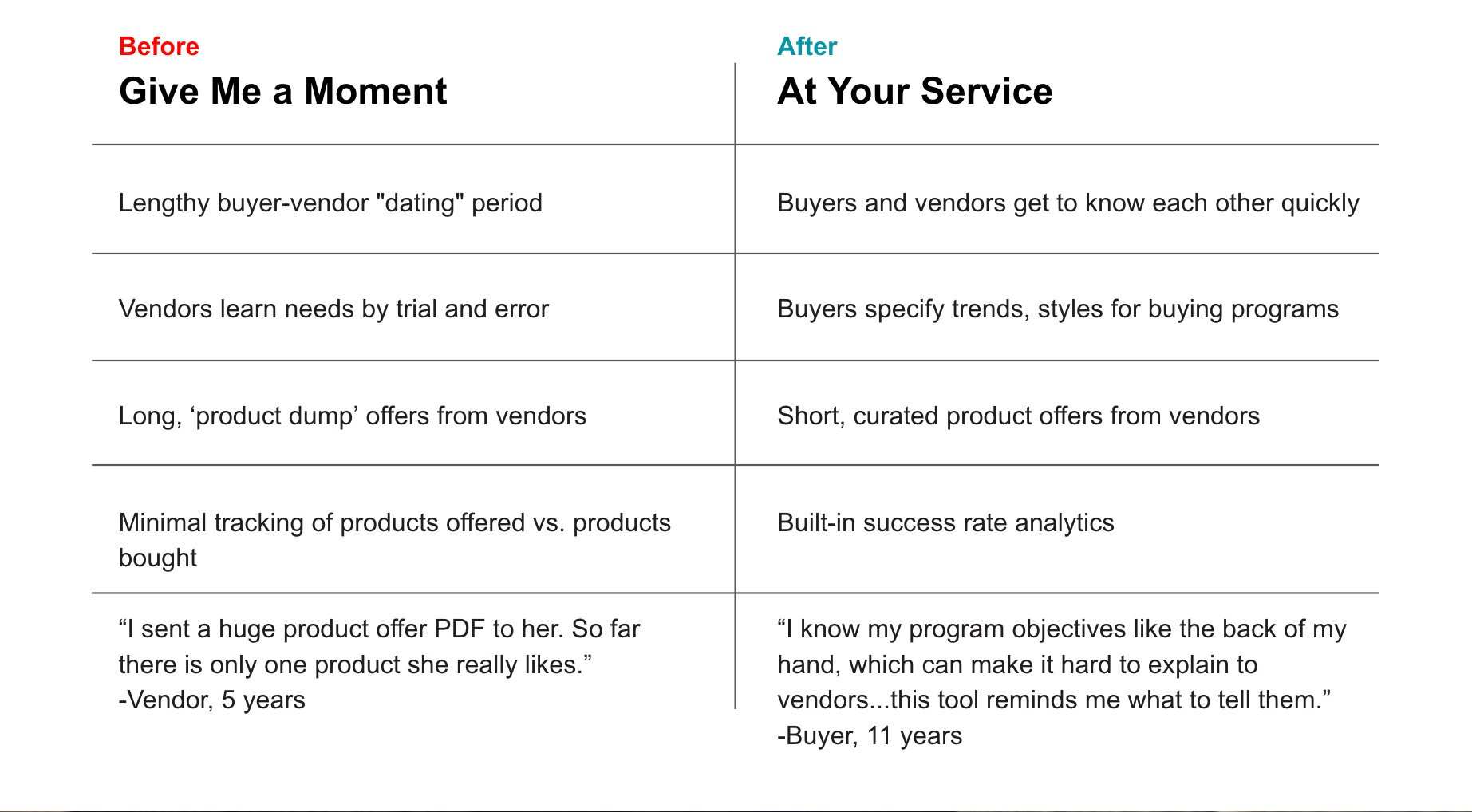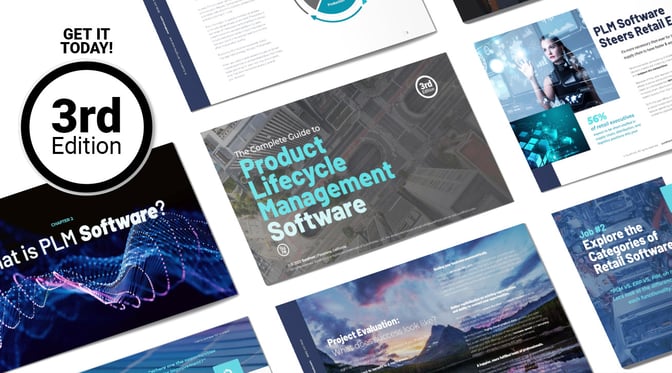Share this
Product Development and Merchandising: At Your Service
by Surefront on Sep 24, 2024 10:00:00 AM
Home > Blog > At Your Service
Table of Contents
Give a Little, Get a Lot
| Efficiency Buyers spend less time reviewing spreadsheets full of products that are off-base for their target customer. |
Efficacy With less products to review, buyers can pick just the right product for their assortment. |
Feelings Buyers feel less overwhelmed by the influx of product offers, and more motivated to review the curated offers they do receive. |
Buyers feel that their needs are catered to, with fantastic customer service from their vendors.
Value 1 of 3
Vendors provide better service when they understand their buyers’ preferences.

There’s a Gaping Hole in the Market
We conducted a competitive analysis of 10 existing buyer-vendor collaboration platforms and found a surprising hole in the market: there are no retailer-focused tools that facilitate high-touch buyer-vendor interaction.
Buyers from large retail companies expect high levels of service from their vendors. These buyers want to feel like their vendor is a "friend who gives great advice." They only work with vendors who are willing to work in 'high-touch interactions': come prepared with products that these buyers are interested in, or be nimble enough to customize.

Very large retailers (think Walmart) have created their own proprietary platforms to meet their needs. However, there are many smaller-but-still-large retailers (think Ross) that are left without a viable solution to this high-touch problem. They write large enough orders to warrant their own platform, but are not large enough to invest in a proprietary solution. With Buying Time on the market, these retailers have access to a platform created for their unique needs.
This is particularly valuable for a major subset of these type of retailers: off-price retailers. Off-price retailers particularly benefit from a tool that consolidates their products, because they do not have e-commerce websites that track product information and inventory.
The Bully on the Playground
Buying is a constant negotiation, with power tactics employed by both sides. In wholesale retail, power dynamics favor the party that has the larger order volume, and also impact the software retailers and vendors choose for purchase order generation.
Retailer > Vendor = Buyer Power

Large retail buyers (think Target) don’t have time to scroll through 1,000+ products in a vendor’s product catalogue. These buyers want their own software platforms, and they have the leeway to mandate that their vendors sign up—or risk losing the retailer's business. We found a dearth of tools that satisfy these buyers’ needs.
Buying 10 products and buying 10,000 products are categorically different activities—large buyers get additional service from their vendors because they are able to place such large product orders.
Retailer < Vendor = Vendor Power

When the retailer is smaller (think small boutique shops), buying can be similar to an e-commerce experience: buyers go to the vendor’s website, pick out what they want, and order products as is. Larger vendors with more sway expect buyers to use their software platforms. This market is saturated.
Small vendors (compared to the retailers they work with) have the advantage of agility. However, they don’t always have the lowest prices that economy of scale brings. To stay competitive, these small vendors have to really know their market, and offer outstanding service to buyers.
Large retail buyers (think Target) don’t have time to scroll through 1,000+ products in a vendor’s product catalogue. These buyers want their own software platforms, and they have the leeway to mandate that their vendors sign up—or risk losing the retailer's business. We found a dearth of tools that satisfy these buyers’ needs.

1) I make it work for my schedule.
I set the timetable for my program to make sure vendors set their production schedule according to my needs.
2) I select who I want to tell. Only the vendors that I specify will see an announcement for a particular program.
3) I tell vendors what I need. I can specify what I want to see in the product offers my vendors send to me, both what is a ‘Need to have’ and a ‘Nice to have.’
4) I give vendors images for inspiration. I can attach a trend board or other files to give vendors visual representations of what I am looking for.
5) I set limits. I can set a maximum number of products an offer can contain in order to keep things manageable for me.

1) I know what my buyer needs. I feel confident submitting my offer to a program my buyer created.
2) I provide my buyer with offer-level information. I specify the lead time for my offer, and can add any additional descriptive text.
3) I marry buyer needs to my capabilities. I choose the products from my catalogue that match up with my buyer’s needs.
You don’t want your data to be siloed. Your company’s CRM, PIM and PLM solutions shouldn’t operate in a vacuum, either. Surefront is a unified product collaboration platform to power growth and ROI. Our patented PIM, CRM, and PLM solutions streamline the omni channel sales, merchandising and product development processes. By combining these essential functionalities, Surefront creates a single source of truth throughout your product lifecycle, sales and listing processes.
The results? Up to 150% more revenue per employee and a 40% shorter product development cycle is just the beginning. Try our 10x ROI calculator to see your company’s potential profits. Or, skip the noise and book a custom demo with one of our unified product collaboration management experts today. The retail industry evolves quickly and has a lot of moving parts. We do all of the research, so you don’t have to. Stay ahead of market fluctuations, trends and new features by subscribing to our Unified Product Collaboration Management Blog.
Further Reading
The Essential Guide to Product Development and Merchandising
Decisive, Not Disorganized
Share this
- PLM Software (32)
- PIM Software (27)
- Trending Topics (20)
- Apparel & Fashion (14)
- CRM Software (12)
- Merchandising (5)
- Success Stories (5)
- Sustainability (5)
- Tech Packs (5)
- Catalog Management (4)
- Luxury Goods & Jewelry (4)
- Product Development (4)
- Retail (4)
- Supply Chain (4)
- Data Import (3)
- Home Furnishings (3)
- Line Sheet (3)
- PLM Implementation (3)
- PLM RFP (3)
- Wholesale (3)
- Category Management (2)
- Consumer Packaged Goods (CPG) (2)
- Cosmetics (2)
- Data Export (2)
- Health & Beauty (2)
- Industry Events (2)
- RFQ & Quote Management (2)
- Consumer Electronics (1)
- Import & Export (1)
- Inventory Management (1)
- Pet Stores (1)
- Purchase Orders (1)
- Report Builder (1)
- Textiles & Raw Materials (1)
- Unified Solution (1)
- Vendor Management (1)
- White Paper or Case Study (1)
- December 2024 (5)
- November 2024 (3)
- October 2024 (5)
- September 2024 (6)
- August 2024 (2)
- July 2024 (1)
- June 2024 (3)
- May 2024 (4)
- April 2024 (5)
- March 2024 (3)
- February 2024 (2)
- December 2023 (4)
- September 2023 (2)
- August 2023 (5)
- July 2023 (3)
- June 2023 (2)
- May 2023 (2)
- April 2023 (4)
- March 2023 (5)
- February 2023 (3)
- January 2023 (5)
- December 2022 (4)
- November 2022 (3)
- October 2022 (4)
- September 2022 (5)
- August 2022 (4)
- July 2022 (3)
- June 2022 (1)
- May 2022 (1)
- February 2022 (1)
- January 2022 (1)
- September 2021 (1)
- May 2021 (1)
- April 2021 (1)
- February 2021 (1)
- December 2020 (1)
- May 2020 (1)

